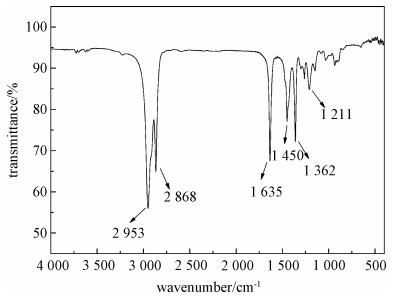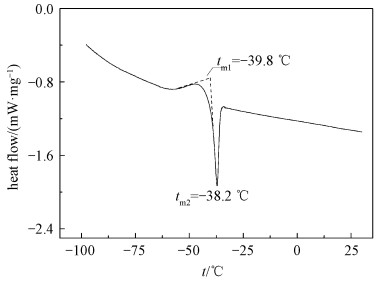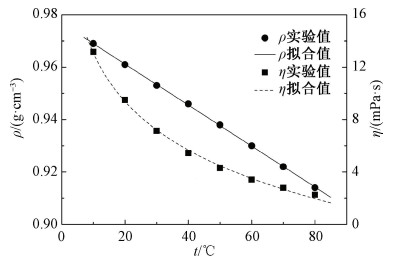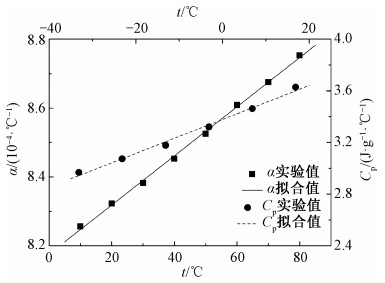

1. 中国石油大学(北京)化学工程与环境学院, 北京 102249;
2. 中国科学院过程工程研究所 中国科学院粉体材料技术重点实验室, 北京 100190;
3. 中国科学院大学化学工程学院, 北京 100049;
4. 郑州中科新兴产业技术研究院, 郑州 450000
2020年1月13日 收稿; 2020年3月18日 收修改稿
基金项目: 国家自然科学基金(21676281,21878278)和北京市自然科学基金(2192054)资助
通信作者: 张延强, E-mail: yqzhang@ipe.ac.cn
摘要: 以环戊基甲基酮和水合肼为原料,合成一种新的酮连氮化合物(环戊基甲基酮连氮,C14N2H24),采用1H NMR、13C NMR和IR表征确认产物的结构,并通过Gaussian 09计算对产物分子构型进行解析,表明(1E,2E)为最稳定构型;同时测定环戊基甲基酮连氮在常压下的基本物理化学性质,包括沸点(Tb,238.4℃)、熔点(Tm,-38.2℃)、密度(ρ,0.910~0.969 g·cm-3)、动态黏度(η,2.35~13.17 mPa·s)和比热容(Cp,2.97~3.63 J·g-1·℃-1),并根据密度计算其等压热膨胀系数(α,8.26×10-4~8.75×10-4℃-1)。结果显示ρ、η与温度呈负相关,Cp、α与温度呈正相关。
关键词: 环戊基甲基酮环戊基甲基酮连氮红外密度比热容
Synthesis and characterization of cyclopentyl methyl ketazine
ZHAO Peng1,2, ZHAO Wenzhao2,3, XIA Yangfeng2,3, LIU Long2, ZHANG Yanqiang2,4


1. College of Chemical Engineering and Environment, China University of Petroleum, Beijing 102249, China;
2. Key Laboratory of Science and Technology on Particle Materials of CAS, Institute of Process Engineering, Chinese Academy of Sciences, Beijing 100190, China;
3. School of Chemical Engineering, University of Chinese Academy of Sciences, Beijing 100049, China;
4. Zhengzhou Institute of Emerging Industrial Technology, Zhengzhou 450000, China
Abstract: In this paper, a new ketazine compound (C14N2H24) was synthesized from cyclopentyl methyl ketone and hydrazine hydrate. After the separation and purification of the product, the structure of cyclopentyl methyl ketazinewas determined by 1H NMR, 13C NMR, and IR spectra. With Gaussian 09 computation, the structure (1E, 2E) of the product was proved to be the most stable molecular configuration. Furthermore, the basic physical and chemical properties of cyclopentyl methyl ketazine under atmospheric pressure were measured, including boiling point (Tb, 238.4℃), melting point (Tm, -38.2℃), density (ρ, 0.910-0.969 g·cm-3), dynamic viscosity (η, 2.35-13.17 mPa·s), and specific heat capacity (Cp, 2.97-3.63 J·g-1·℃-1). The thermal expansion coefficient (α, 8.26×10-4-8.75×10-4℃-1) was calculated according to its density.The results show that ρ and η have a positive correlation with temperature while Cp and α have a negative correlation with temperature. The obtained data and correlation formula are very valuable for the industrial application of cyclopentyl methyl ketazine.
Keywords: cyclopentyl methyl ketonecyclopentyl methyl ketazineinfrareddensityspecific heat capacity
酮连氮是一类具有—CN—NC—结构的化合物,其分子中存在共扼双键,具有多种共振结构。这一特殊的结构特征决定了酮连氮类化合物的独特性质和多种多样的反应潜力[1], 目前酮连氮类化合物已广泛应用于染料、医药中间体、合成材料、可聚合单体等工业领域[2-4]。例如:2, 4-二氮芴-9-酮连氮是一种重要的多联吡啶配体,能与许多过渡金属形成配合物,作为中性协同配体时,可提高稀土配合物的荧光强度,从而避免配合物与溶剂相互作用而引起的荧光猝灭[5]。在合成材料方面,利用酮连氮制备水性聚氨酯,是一种主要的工业合成方法[6];另外,工业上应用广泛的偶氮化合物也主要是酮连氮经过还原、氧化后制备[7];1982年Baldwin[8]等详细报道了利用酮连氮合成吡咯的新方法,并且得到一系列具有不对称结构的吡咯。在农药应用方面,2006年Verner等[9]报道了在乙酸存在时脂肪族酮连氮与氰酸钾或硫氰酸可以发生环加成反应生成三唑类化合物;2005年Shang等[10]报道了用[二碘]苯作为氧化剂对酮连氮进行氧化制备1, 3, 4-噁二唑。在医药应用方面,1981年Robev[11]报道了一种利用酮连氮合成二氮杂萘衍生物的新方法;1977年Evans等[12]报道了脂肪族酮连氮与丁二炔二酸二甲酯、丙烯酸甲酯反应,根据酮连氮的结构性质不同可得到α, β-不饱和酮连氮或者N-丙烯基吡唑产物[13]。设计新型的酮连氮化合物对提升其应用领域意义重大[14], 其中作为典型五元环对称结构的环戊基甲基酮连氮,有望在医药和新材料领域实现应用,而针对环戊基甲基酮连氮的研究尚未见报道。
本文以环戊基甲基酮和水合肼为原料,对环戊基甲基酮连氮(C14N2H24)的合成、表征进行研究。通过1H NMR、13C NMR和IR光谱分析,多方面确认产物的结构,利用Gaussian 09计算对产物的构型和分子振动进行解析;同时,针对环戊基甲基酮连氮的物性参数,如密度、黏度、热膨胀系数、比热容、熔点和沸点等,进行系统的测定。
1 实验部分1.1 试剂水合肼,分析纯(80.0%),天津市大茂化学试剂公司;环戊基甲基酮,分析纯(98.0%),国药集团化学试剂有限公司;无水MgSO4,分析纯(99.9%),上海麦克林生化科技有限公司;无水乙醇,分析纯(99.8%),阿拉丁试剂(上海)有限公司;KBr,光谱级(99.5%),阿拉丁试剂(上海)有限公司;DMSO-d6(99.9%),上海麦克林生化科技有限公司。
1.2 酮连氮的合成如图 1所示,采用水合肼法制备环戊基甲基酮连氮[15]。将环戊基甲基酮(44.86 g,400 mmol)倒入装有温度计、回流冷凝管的三口烧瓶,在磁子搅拌下滴加水合肼(12.58 g,200 mmol),滴加完毕后,反应液升温至100 ℃并回流8 h。反应结束后,将反应液倒入分液漏斗、静置30 min。反应液分为两相,取上层油相用无水MgSO4干燥,过滤出粗产物。将得到的粗产物在减压(100 mbar)下缓慢蒸馏,获得环戊基甲基酮连氮产品(26.82 g,122 mmol;收率:60.9%),为淡黄色透明液体。1H NMR (600 MHz, DMSO) δ=3.32 (s, 6H, CH3), 2.75~2.61 (m, 2H, CH), 1.88~1.47×10-6 (m, 16 H, CH2); 13C NMR (151 MHz, DMSO) δ=162.1, 47.2, 29.4, 25.0, 15.3×10-6; IR (KBr): v=2 953, 2 868, 1 635, 1 450, 1 362, 1 211, 937 cm-1。
Fig. 1
 | Download: JPG larger image |
| 图 1 环戊基甲基酮连氮合成路线 Fig. 1 Synthesis of cyclopentyl methyl ketazine 图 1 环戊基甲基酮连氮合成路线 Fig. 1 Synthesis of cyclopentyl methyl ketazine --> | |
1.3 分析方法核磁测试:Bruker 600 MHz光谱仪,使用DMSO-d6做溶剂,在600 MHz下获得1H NMR谱图,在151 MHz下获得13C NMR谱图。
红外光谱测试:Thermo Nicolet 380红外分析仪,测试过程中以KBr制片作为背景。
沸点测定[16]:将一个500 mL三口烧瓶、190 mm长试管以及测量范围为0~300 ℃的全浸式水银温度计用胶塞连接,胶塞外侧具有出气槽;将一根测量范围为0~50 ℃的辅助温度计附在测量温度计上,使其水银球位于测量温度计露出胶塞外水银柱的中部;烧瓶中注入约为其体积1/2的耐高温硅油,试管中注入适量待测液体,使其液面略低于烧瓶中硅油液面,测量温度计水银球下段与待测液体液面相距约20 mm。用电加热套给烧瓶加热,当待测温度计数值上升到某一定值并在一段时间内保持不变时,记录下此温度值,同时记录下辅助温度计数值、胶塞上沿测量温度计数值和大气压力值。
DSC测试:Mettler-Toledo DSC1差示扫描量热仪,试样量取3~5 mg,将样品封装在开有微孔的铝盘中,置于N2环境下的传感器上,N2流量设定为50 mL·min-1。
密度黏度测试:DMA5000M-Lovis2000ME密度黏度计,测量精度分别为± 1.0×10-3 g·cm-3和±1.0×10-2 mPa·s。用注射器将样品直接注入测量室,测温范围为10~80 ℃,10 ℃/间隔,由加热系统控制温度,精度为±0.1 ℃。所有测量均在相同条件下进行3次,取平均值。
2 实验结果与讨论2.1 酮连氮的结构表征2.1.1 分子单点能计算为确定环戊基甲基酮连氮的稳态分子结构,运用Gaussian 09程序计算环戊基甲基酮连氮分子的单点能值。利用基于DFT理论的B3LYP杂化型交换相关泛函[17],采用6-311++G(2d, p) 基组对其结构与频数进行优化,得到3个稳态的结构,它们表现出可逆的异构化过程,如图 2所示。
Fig. 2
 | Download: JPG larger image |
| 图 2 环戊基甲基酮连氮的3个异构体 Fig. 2 Three isomers of cyclopentyl methyl ketazine 图 2 环戊基甲基酮连氮的3个异构体 Fig. 2 Three isomers of cyclopentyl methyl ketazine --> | |
利用基于多体微扰理论的MP2方法[18],采用6-311++G(2d, p)基组进行计算,得到环戊基甲基酮连氮3个异构体的单点能Esp(single point energy),如表 1所示。其中,结构(1E, 2E)的能量最低:-655.686 213 1 a.u.;以结构(1E, 2E)单点能为基准,结构(1Z, 2Z)和(1Z, 2E)与其单点能差值ΔEsp也列于表 1。从能量角度考虑,结构(1E, 2E)是3种结构中的最优构型,但三者能差较小,证明环戊基甲基酮连氮化合物应是3种构型的混合状态。
Table 1
| 表 1 环戊基甲基酮连氮的单点能Table 1 Single point energy of cyclopentyl methyl ketazine | |||||||||||||||
2.1.2 核磁谱图分析分别采用1H NMR、13C NMR对环戊基甲基酮连氮的结构进行确认,结果见实验部分。在1H NMR谱图中,化学位移在3.32×10-6处为2个甲基(CH3)的H原子;化学位移在2.75~2.61×10-6处为2个次甲基(CH)的H原子;化学位移在1.88~1.47×10-6处为戊环上的8个亚甲基(CH2)的H原子。在13C NMR谱图中,化学位移在162.1×10-6处为双键(C=N)的C原子;化学位移在47.2×10-6处为戊环上次甲基(CH)的C原子;化学位移在29.4×10-6处为戊环上α-亚甲基(CH2)的C原子;化学位移在25.0×10-6处为戊环上β-亚甲基(CH2)的C原子;化学位移在15.3×10-6处为甲基(CH3)的C原子。
2.1.3 红外光谱解析为进一步确认环戊基甲基酮连氮的结构,测试其红外光谱,如图 3所示,并采用量化计算对其谱图进行指认[19]。
Fig. 3
 | Download: JPG larger image |
| 图 3 环戊基甲基酮连氮的红外谱图 Fig. 3 IR spectrum of cyclopentyl methyl ketazine 图 3 环戊基甲基酮连氮的红外谱图 Fig. 3 IR spectrum of cyclopentyl methyl ketazine --> | |
量化计算运用Gaussian 09程序,采用B3LYP泛函[17]以及6-311++G(2d, p)基组方法。环戊基甲基酮连氮分子结构(1E, 2E)的各种振动频率计算结果及红外测试实验结果列于表 2,在特征化学键的振动吸收频率方面,二者表现出良好的一致性。
Table 2
| 表 2 环戊基甲基酮连氮红外光谱的波数及其指认Table 2 Wave number and identification of IR spectrum of cyclopentyl methyl ketazine |
在IR光谱曲线中,1 211 cm-1为环戊基中CH2的摇摆振动吸收峰,由于环的限制,碳骨架比较稳定,所以出峰位置出现红移;1 362和1 450 cm-1分别为CH3的扭转和剪式振动吸收峰;1 635 cm-1为CN双键的伸缩振动吸收峰,由于共轭效应的存在[20],其出峰位置出现红移;2 868 cm-1为CH2(戊环)的伸缩振动吸收峰,由于环张力的影响,其出峰位置出现蓝移;2 953 cm-1为CH3特征吸收峰。
2.2 环戊基酮连氮的理化性质2.2.1 沸点采用《化学试剂:沸点测定通用方法》[16]对环戊基甲基酮连氮的沸点进行测定,得到测量温度值tp为233.0 ℃,辅助温度计测量值ta为11.4 ℃,胶塞上沿测量温度计数值tb为80.2 ℃,同时记录气压计压力值为101.33 kPa。
沸点的计算公式如下
| $t = {t_{\rm{p}}} + \Delta t, $ | (1) |
| $\Delta t = 0.000\;16({t_{\rm{p}}} - {t_{\rm{a}}})({t_{\rm{p}}} - {t_{\rm{b}}}), $ | (2) |
将实验记录数据代入上式,得到在101.33 kPa和11.4 ℃条件下环戊基甲基酮连氮的真实沸点为238.4 ℃。
2.2.2 熔点环戊基甲基酮连氮的熔点采用差示扫描量热熔点分析法进行测试[21-22],温度扫描范围选为-100~30 ℃,升温速率选为5 ℃·min-1。如图 4所示,环戊基甲基酮连氮的DSC曲线明确显示出其熔化温度(起始温度和峰值温度)[23-24],其中起始温度为(tm1,-39.8 ℃),峰值温度为(tm2,-38.2 ℃)。
Fig. 4
 | Download: JPG larger image |
| 图 4 环戊基甲基酮连氮的DSC曲线 Fig. 4 DSC curve of cyclopentyl methyl ketazine 图 4 环戊基甲基酮连氮的DSC曲线 Fig. 4 DSC curve of cyclopentyl methyl ketazine --> | |
2.2.3 密度与黏度采用密度黏度计(DMA5000M-Lovis2000ME,奥地利),测试环戊基甲基酮连氮在不同温度下的密度(ρ)和动态黏度(η)。环戊基甲基酮连氮的密度、黏度与温度的函数关系如图 5所示。其中密度呈线性下降趋势,黏度呈对数下降趋势,这是由温度升高,液体分子动能增加,分子间距变大、范德华作用力减弱所致。
Fig. 5
 | Download: JPG larger image |
| 图 5 环戊基甲基酮连氮密度、黏度与温度的关系 Fig. 5 Density and viscosity as functions of temperature for cyclopentyl methyl ketazine 图 5 环戊基甲基酮连氮密度、黏度与温度的关系 Fig. 5 Density and viscosity as functions of temperature for cyclopentyl methyl ketazine --> | |
依据实验数据得到2个拟合方程[25-26]
| $\rho = - 7.82 \times {10^{ - 4}}t + 0.97, $ | (3) |
| $\eta = - 5.32\ln \left( {1 + 430.03t} \right) + 57.61, $ | (4) |
其预测结果与实验值吻合度较高(R12=0.999,R22=0.996)。由于良好的拟合度,式(3)和式(4)可分别用于计算10.0~80.0 ℃温度范围内环戊基甲基酮连氮的密度和黏度值。
2.2.4 等压热膨胀系数根据环戊基甲基酮连氮的密度,利用下式可以计算其等压热膨胀系数[27-28],结果如表 3所示。
| $\alpha = \frac{1}{{{V_m}}}{\left( {\frac{{\partial {V_m}}}{{\partial T}}} \right)_p} = - \frac{1}{\rho }{\left( {\frac{{\partial \rho }}{{\partial T}}} \right)_p}, $ | (5) |
| 表 3 环戊基甲基酮连氮在常压下的热膨胀系数Table 3 Thermal expansion coefficient of cyclopentyl methyl ketazine at atmospheric pressure |
式中:α是热膨胀系数,单位为10-4·K-1;ρ是密度,单位为g·cm-3;Vm是摩尔体积,单位为cm3·mol-1;T是温度,单位为K。
依据数据得到拟合方程[29]
| $\alpha = 0.007\;1\;t + 8.176\;1, $ | (6) |
其预测结果与实验值吻合良好(R2=0.998)(图 6)。在该温度范围内,环戊基甲基酮连氮的等压热膨胀系数随温度的升高呈线性增加,由于良好的拟合度,该式可用于10.0~80.0 ℃温度范围内等压热膨胀系数值的计算。
Fig. 6
 | Download: JPG larger image |
| 图 6 环戊基甲基酮连氮的热膨胀系数、比热容与温度的关系 Fig. 6 Thermal expansion coefficient and specific heat capacity as functions of temperature for cyclopentyl methyl ketazine 图 6 环戊基甲基酮连氮的热膨胀系数、比热容与温度的关系 Fig. 6 Thermal expansion coefficient and specific heat capacity as functions of temperature for cyclopentyl methyl ketazine --> | |
2.2.5 比热容环戊基甲基酮连氮的比热容采用蓝宝石法进行测定,该法具有很高的准确度[30-32]。采用差示扫描量热仪(瑞士Mettler-Toledo)对数据进行记录和分析,鉴于环戊基甲基酮连氮的高挥发性,测试温度范围选定为-33.2~16.9 ℃。经过计算处理后,环戊基甲基酮连氮的比热容数据列于表 4中。
Table 4
| 表 4 环戊基甲基酮连氮在常压下的比热容Table 4 Specific heat capacity of cyclopentyl methyl ketazine at atmospheric pressure |
依据数据得到拟合方程[26-27]
| ${C_{\rm{p}}} = 0.013\;1\;t + 3.375\;6, $ | (7) |
其预测结果与实验值吻合度较高(R2=0.994)(图 6)。在该温度范围内,随温度升高,环戊基甲基酮连氮比热容值呈线性增加,由于良好的拟合度,该式可用于计算-33.2~16.9 ℃温度范围内的Cp值。
3 结论设计合成了环戊基甲基酮连氮,通过1H NMR、13C NMR、IR等表征手段对其结构进行确认;通过Gaussian 09计算得到其分子的红外振动特性,其单点能计算,证明结构(1E, 2E)为分子最稳定构型;测量环戊基甲基酮连氮在常温、常压下的沸点(238.4 ℃)、熔点(-38.2 ℃)、密度(0.910~0.969 g·cm-3)、动态黏度(2.35~13.17 mPa·s)、比热容(2.97~3.63 J·g-1·℃-1)等基本物理化学性质,并根据密度计算其热膨胀系数(8.26×10-4~8.75×10-4 ℃-1)。相比ρ、η随温度升高而降低,α、Cp则随温度升高而增大。所得物性参数和关联式可以为环戊基甲基酮连氮的未来化工应用提供重要数据支撑。
参考文献
| [1] | 顾春思, 王涛, 田恒水. 过氧化氢法合成丁酮连氮的工艺研究[J]. 化学试剂, 2018, 40(1): 89-92. |
| [2] | 段江丽, 孙孟展, 裴文. 酮连氮化合物的合成及其应用研究进展[J]. 化工生产与技术, 2009, 16(4): 38-43. Doi:10.3969/j.issn.1006-6829.2009.04.013 |
| [3] | Sengul A, Kurt O, Buyukgungor O. A 2D network silver coordination polymer with the multimodal ligand 2-pyrazyl methyl ketazine[J]. Structural Chemistry, 2011, 22(4): 925-929. Doi:10.1007/s11224-011-9778-z |
| [4] | Tamaru Y, Harada T, Yoshida Z. Novel rearrangement of ketazine dianion: new synthetic route to pyrrole, tetrahydropyridazine, and pyrazole[J]. The Journal of Organic Chemistry, 1978, 43(17): 3370-3374. Doi:10.1021/jo00411a023 |
| [5] | 李文连. 稀土有机配合物发光研究的新进展[J]. 化学通报, 1991(8): 1-9. |
| [6] | 王宏晓, 商士斌, 王丹, 等. 改进水性聚氨酯性能的方法研究进展[J]. 林产化学与工业, 2010, 30(1): 123-126. |
| [7] | Wang C H, Cohen S G. Mercaptan catalysis in thermoneutral free radical exchange[J]. Journal of the American Chemical Society, 1957, 79(8): 1924-1929. Doi:10.1021/ja01565a042 |
| [8] | Baldwin J E, Bottaro J C. A general synthesis of pyrroles from aldehydes and ketones[J]. Journal of the Chemical Society, Chemical Communications, 1982(11): 624-625. Doi:10.1039/c39820000624 |
| [9] | Verner J, Potacek M. Criss-cross cycloadditions on ketazines derived from alicyclic ketones[J]. Molecules, 2006, 11(1): 34-42. Doi:10.3390/11010034 |
| [10] | Shang Z, Reiner J, Chang J, et al. Oxidative cyclization of aldazines with bis (trifluoroacetoxy) iodobenzene[J]. Tetrahedron Letters, 2005, 46(15): 2701-2704. Doi:10.1016/j.tetlet.2005.02.067 |
| [11] | Robev S K. Phthalazine derivatives from aromatic aldazines[J]. Tetrahedron Letters, 1981, 22(4): 345-348. Doi:10.1016/0040-4039(81)80093-7 |
| [12] | Evans S, Gearhart R C, Guggenberger L J, et al. Reactions of azines with electron-deficient alkynes. Formation of 1,5-dihydropyrazolo[1,2-a] pyrazoles, α,β-unsaturated azines, and N-allyl- and N-propenylpyrazoles[J]. The Journal of Organic Chemistry, 1977, 42(3): 452-458. Doi:10.1021/jo00423a014 |
| [13] | 尤彩霞. 吡唑啉、异噁唑啉类衍生物的合成及应用研究[D]. 兰州: 兰州理工大学, 2016. |
| [14] | Kishore J, Thiyagarajan S, Gunanathan C. Ruthenium (Ⅱ)-catalysed direct synthesis of ketazines using secondary alcohols[J]. Chemical Communications, 2019, 55(31): 4542-4545. Doi:10.1039/C9CC01383K |
| [15] | 刁正坤. 己酮连氮合成工艺的改进研究[J]. 四川化工与腐蚀控制, 1998(6): 2-3. |
| [16] | 中华人民共和国国家质量监督检验检疫总局, 中国国家标准化管理委员会. 化学试剂沸点测定通用方法: GB/T 616-2006[S]. 北京: 中国标准出版社, 2006. |
| [17] | Stephens P J, Devlin F J, Chabalowski C F N, et al. Ab initio calculation of vibrational absorption and circular dichroism spectra using density functional force fields[J]. The Journal of Physical Chemistry, 1994, 98(45): 11623-11627. Doi:10.1021/j100096a001 |
| [18] | 武志坚, 孟庆波. La2C分子的MP2及密度泛函理论研究[J]. 原子与分子物理学报, 1998, 15(3): 383-385. |
| [19] | Liu L, He C, Wang H, et al. Synthesis and characterization of ethylenediaminium nitrophenolate[J]. Journal of Molecular Structure, 2011, 989(1-3): 136-143. Doi:10.1016/j.molstruc.2010.12.052 |
| [20] | Katritzky A R, Singh S, Kirichenko K, et al. 1-Butyl-3-methylimidazolium 3,5-dinitro-1,2,4-triazolate: a novel ionic liquid containing a rigid, planar energetic anion[J]. Chemical Communications, 2005(7): 868-870. Doi:10.1039/b414683b |
| [21] | Mathis D, Blanchet P, Landry V, et al. Thermal characterization of bio-based phase changing materials in decorative wood-based panels for thermal energy storage[J]. Green Energy & Environment, 2019, 4(1): 56-65. |
| [22] | 苏小琴, 龙伟, 刘秀兰, 等. 差示扫描量热仪的影响因素及测试技术[J]. 分析仪器, 2019(4): 74-79. Doi:10.3969/j.issn.1001-232x.2019.04.015 |
| [23] | 吴锐, 林兰, 严菁, 等. 差示扫描量热熔点分析法的应用性分析[J]. 化学试剂, 2020, 42(3): 285-290. |
| [24] | Kuduva S S, Sarma J A R P, Katz A K, et al. Melting-points of the meta-and para-isomers of anisylpinacolone[J]. Journal of Physical Organic Chemistry, 2000, 13(11): 719-728. Doi:10.1002/1099-1395(200011)13:11<719::AID-POC308>3.0.CO;2-2 |
| [25] | Hulse R J, Basu R S, Singh R R, et al. Physical properties of HCFO-1233zd (E)[J]. Journal of Chemical & Engineering Data, 2012, 57(12): 3581-3586. |
| [26] | Ben Ghanem O, Mutalib M I A, Lévêque J M, et al. Studies on the physicochemical properties of ionic liquids based on 1-octyl-3-methylimidazolium amino acids[J]. Journal of Chemical & Engineering Data, 2015, 60(6): 1756-1763. |
| [27] | Sanchez L G, Espel J R, Onink F, et al. Density, viscosity, and surface tension of synthesis grade imidazolium, pyridinium, and pyrrolidinium based room temperature ionic liquids[J]. Journal of Chemical & Engineering Data, 2009, 54(10): 2803-2812. |
| [28] | Marcinkowski ?, Kloskowski A, Namie?nik J. Physical and thermophysical properties of 1-hexyl-1,4-diaza[2.2.2] bicyclooctanium bis (trifluoromethylsulfonyl) imide ionic liquid[J]. Journal of Chemical & Engineering Data, 2014, 59(3): 585-591. |
| [29] | Pokorny V, Serra P B P, Fulem M, et al. Heat Capacity and Phase Behavior of Selected Oligo (ethylene glycol) s[J]. Journal of Chemical & Engineering Data, 2019, 64(6): 2742-2749. |
| [30] | Gómez E, Calvar N, Domínguez á, et al. Thermal analysis and heat capacities of 1-alkyl-3-methylimidazolium ionic liquids with NTf2-, TFO-, and DCA- anions[J]. Industrial & Engineering Chemistry Research, 2013, 52(5): 2103-2110. |
| [31] | Riesen R, Widmann G, Truttmann R. Alternating thermal analysis techniques[J]. Thermochimica Acta, 1996, 272: 27-39. Doi:10.1016/0040-6031(95)02608-8 |
| [32] | Krishnan R V, Nagarajan K. Evaluation of heat capacity measurements by temperature modulated differential scanning calorimetry[J]. Journal of Thermal Analysis and Calorimetry, 2010, 102(3): 1135-1140. Doi:10.1007/s10973-010-0770-4 |
